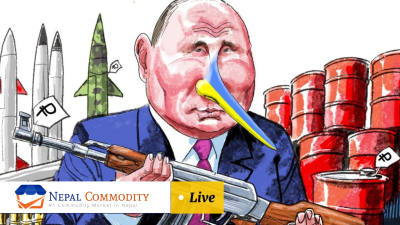- Phone: +977-9808226344
- Email: critnepal@gmail.com

Hello and welcome to Elements, our daily energy and commodities newsletter. Today, NepalCommodity Opinion’s considers Russia’s latest retaliation to energy sanctions, while OPEC’s top official calls on countries to plow more money into oil and Australia’s coal export industry takes another blow. If you haven’t yet signed up to get Elements sent to your inbox, you can do that here.
ADVERTISEMENTS
Russia’s plan to cut oil production by 500,000 barrels a day next month — roughly 5% of its January output and 0.5% of global supply — was a show of strength. In response to what Kremlin officials call the West’s “destructive energy policy,” this was supposed to be a reminder that President Vladimir Putin still holds crucial hydrocarbon cards.
And yet, the past few days have laid bare Moscow’s weaknesses, too.
Friday’s announcement was no shock. Russia has been making liberal use of the energy weapon for months. Officials, and indeed Putin himself, explicitly threatened output cuts in response to sanctions and “stupid” price caps. Moscow does have an agreement to target a certain level of supply as part of the OPEC+ oil producers’ club, but unilateral reductions are not unheard of.
It is, though, bad news for the global economy, pushing up the oil price and threatening to stoke inflation at a time when Chinese consumption is recovering. Russia’s partners in OPEC+, meanwhile, are more concerned with keeping output steady than filling the gap.
Russia may also cut further. Alexander Isakov of Bloomberg Economics points out that early February production stood at 10.9 million barrels a day, but the budget was built around 9.8 million barrels — leaving space for more pain to be inflicted.
Russia's oil output has rebounded after the spring sanctions shock
Sources: Bloomberg News calculations based on the Energy Ministry's CDU-TEK data, media reports
But none of this means all is well in Fortress Russia. For one, the country’s cuts add risks and costs for its own producers, which have already had to become increasingly ingenious to keep mature fields alive. There is a limit to how much can be reduced without hurting future output. This energy weapon cannot keep firing, so deploying it now is a meaningful choice.
It may be a sign that Moscow already has more volumes than it can handle. It’s early to measure the impact of sanctions on oil products, but Russia will probably find it harder to source Asian buyers for its refined products than for its crude. China and India have plenty of refineries, after all.
The Kremlin certainly needs higher prices. Discounts on Urals crude already are causing significant pain, with the government’s oil and gas revenues in January down 46% from a year ago, while spending jumped. No wonder the government has now proposed limiting the discount to Brent for tax purposes.
Russia’s resilience — and Putin’s willingness to sacrifice the future — shouldn’t be underestimated, and the production cut sets a worrying precedent. But the signal is decidedly mixed.
Source: Bloomberg
After the optimism of recent months, a pause seems in order for iron ore as questions emerge over the speed of China’s post-Covid demand recovery. Home sales continued to slump in January. Construction activity has restarted, but steel procurement appears to be lagging. According to Steelhome, stockpiles of iron ore at ports across China last week rose to the highest level since September.
Europe is sitting on some of its highest gas stockpiles in years, and much of that supply is effectively stuck. Prices have plunged from their August peak, meaning sales from inventories could come at a loss of billions of euros to energy users and taxpayers.
Risks to the renewables boom via the mining industry don’t get enough attention, according to the Church of England Pensions Board’s Adam Matthews. Portfolios touting ESG principles may end up exposed to human-rights abuses and environmental damage via supply chains, the CEPB’s chief responsible investment officer says.
When news broke that Trafigura Group faces more than half a billion dollars in losses from what it described as a “systematic fraud,” the biggest surprise for many market insiders was that the trading giant was still doing business with a man that others had long since backed away from: Indian businessman Prateek Gupta.
OPEC’s top official urged countries to invest more in oil to meet future energy needs and said climate policies need to be more “balanced and fair.” Meanwhile, Saudi Aramco warned that an increased focus on climate was undermining oil and gas investment to the point where it now posed a threat to global energy security.
Australia’s A$133 billion ($92 billion) coal export sector suffered another blow after billionaire Clive Palmer’s Waratah Coal Inc. withdrew an appeal to open what would have been the country’s biggest mine.
Monday: World Government Summit, Dubai (through Feb. 15); earnings from Galp Energia SGPS SA.
Tuesday: BNEF Forum Seoul; OPEC monthly oil market report; American Petroleum Institute’s weekly report on US oil inventories; earnings from Devon Energy Corp., Norsk Hydro ASA, Boliden AB, Thyssenkrupp AG, Cleveland-Cliffs Inc., Livent Corp., First Quantum Minerals Ltd.
Wednesday: IEA-IEF-OPEC Symposium, Riyadh; IEA monthly oil market report; Energy Information Administration’s weekly report on US oil inventories, supply and demand; Singapore Steel and Raw Materials Conference 2023; earnings from Glencore Plc, Fortescue Metals Group Ltd., Barrick Gold Corp.
Thursday: International Grains Council monthly report; Russian Grain Conference in Sochi; EIA weekly report on US gas inventories; earnings from Repsol SA, Centrica Plc, Cenovus Energy Inc., Newcrest Mining Ltd., South32 Ltd., Agnico Eagle Mines Ltd., Vale SA, Iamgold Corp.
Friday: Earnings from Mol Nyrt.
Source: Bloomberg.com
ADVERTISEMENT